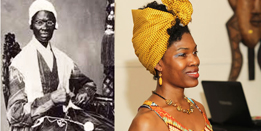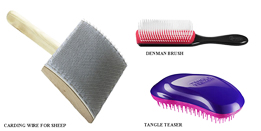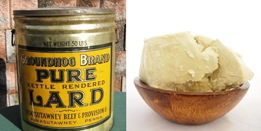Celebrating Our
African-American Heritage
By
Megan Davis
Soulcial Scene Contributor
African-American heritage is
something that is widely celebrated during the month of
February in the United States. We teach our children about
slavery, Martin Luther King, Jr., black inventors, the first
African-American president and maybe some Negro spirituals.
Yet, there is so much more to
African-American heritage that gets overlooked such as
famous poets, actors, composers, and the many other
activists who shared the Civil Rights movement with The Rev.
Dr. King and even Malcolm X.
And then there is Black Hair,
which is a culture in and of itself.
Today, when people think of
African culture, one of the most popular connections is in
attire. The Dashiki, in various styles for men and women, is
a particular shirt, or pants set with a pattern that shouts
“Africa” and the second most popular fabric is Kente.
Finally, the headwrap is a trending accessory women and even
men are wearing in celebration of their heritage.
Current trends in hairstyles
also reflect that of a long and rich African-American
culture from Afros to cornrows to braids. Knowing the
background of certain hairstyles and practices are a great
way to learn about African-American heritage. Once in the
know, it helps people feel connected to something deeper
than the stereotypical black family culture of today in
America.
Before slavery, America and
the pressing comb, Africans were unashamedly naturally
beautiful, progressive, resourceful and innovative. Their
hairstyles were often a direct statement of status, age and
identity. In some villages, long hair may have represented
the elders while intricate cornrow designs may have
signified a royal family. Hairstyles may have also
represented marital status, adolescence and financial
status.
|

Headwrap on a slave and a headwrap modeled by Tosha Easter,
styled by Lladheena Shabazz both of Toledo

Sheep's carding wire, a Denman brush, a Tangle Teaser

Black Panther Party Kathleen Cleaver, World's largest Afro
record holder Aevin Douglas

Pure lard, Raw Shea Butter

African coils, Cropped sponge coils |
|
Once sold across the waters,
Africans became slaves. They came to a place where they had
to adapt to the culture that was already established.
Working long hours in the hot sun, slaves didn’t have time
to sit in the shade and braid each other’s hair while
talking about life. Because they were now African Americans,
they had to look the part. Natural styles weren’t acceptable
for house slaves, and there wasn’t enough time for field
slaves to create their native styles. They had to create a
new hair care regimen that suited their new life. With
regard to innovation, slaves created many tools from
household objects to manage their hair.
Some examples include:
• Using a fork and placing it on open fire to comb through
the hair and straighten it. Later, a pressing comb was
created.
• Using flat iron that was intended for clothing
straightened hair and today a hand held flat irons that plug
in are being used.
• For detangling, sheep’s carding wire was used because it
had many metal prongs that kept wool from clumping together.
Today, there is the Tangle Teaser and the Denman Brush
• Lard, kerosene or axle grease was used to soften the hair
and protect the scalp from getting lice or ringworm. Today,
there are many oils, butters and pomades used to condition
the scalp and hair.
• White linen headscarves were once used to protect the hair
from being in the sun for long hours. It kept the head cool
and the hair safe from the elements. Today, intricate
headwraps are worn for style.
These practices were and
still are being used in homes around the world. We have also
adopted many hairstyles once worn by Africans in their
native land. Women with very short hair often had tiny coils
in it. Today we call the style a cropped natural with sponge
curls. Bantu knots were small erect coils of hair neatly
placed upon the head and today they are a style worn to
create a curlier hair pattern.
The Himba people wore a mixture of red clay on their hair
and bodies to help keep their skin clean due to water
scarcity as well as on their hair to protect it from the sun
and high temperatures. Today women wear clay masks on their
faces and in their hair as a way to deep clean the skin and
condition their hair.
Cornrows were created by skilled braiders, the elder women,
in intricate styles and remain an African-American beauty
art form. Long locs were worn by Egyptian Kings and are the
crown and glory of many men and women, especially in the
Rastafarian culture today.
The Afro, during the Civil
Rights Movement was worn as a sign of “Black Pride” and the
return to African culture, growing out the hair without
chemicals after adhering to the white American beauty
esthetic for generations.
Today, as many women are returning to natural hair, they are
also become a more conscious group. From reading books on
black history to going to poetry slams and rocking headwraps,
women of today are finding ways to connect to their
African-American roots and way they can. Currently, the Afro
is the most celebrated African-American hairstyle around the
world. Women are foregoing the straightening chemicals that
once were oppressors and are embracing their natural texture
more and more.
Black Americans, like
Africans before slavery, today are becoming more and more
resourceful with the black hair care Industry being at the
forefront of many endeavors. While Madam CJ Walker may have
been the first female African-American self-made
millionaire, today, several women own hair care companies
which have sprouted up within the last five years and that
have surpassed her great achievement.
Using natural ingredients and ancient herbal remedies, hair
care products for black men, women and children are now
widely available in stores and online with no signs of
recession. In Toledo, Powell's Beauty Supply is the oldest
and only black beauty supply store which has been a resource
for cosmetologists and consumers for many years. Because of
the ancestral heritage of innovation, African Americans
today are rich with culture, wealthy in business and filled
with pride.
|